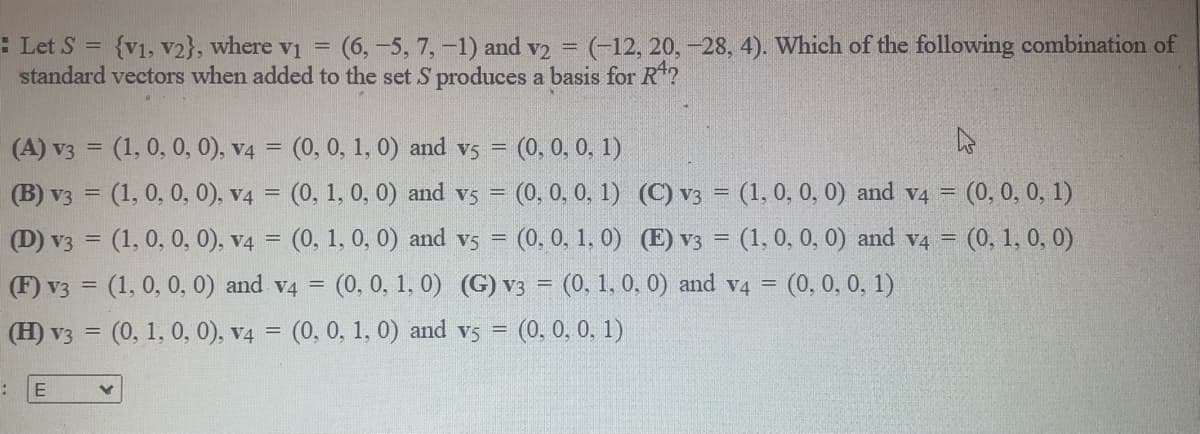: Let S = {v1, v2}, where v = standard vectors when added to the set S produces a basis for R? (6,-5, 7,-1) and v2 = (-12, 20, -28, 4). Which of the following combination of (A) v3 = (1, 0, 0, 0), v4 = (0, 0, 1, 0) and vs = (0, 0, 0, 1) (B) v3 = (1, 0, 0, 0), v4 = (0, 1, 0, 0) and v5 (D) v3 = (1, 0, 0, 0), v4 = (0, 1, 0, 0) and vs = (0. 0, 1, 0) (E)v3 = (1, 0, 0, 0) and v4 = (0, 1, 0, 0) (F) v3 = (1, 0, 0, 0) and v4 = (0, 0, 1, 0) (G) v3 = (0, 1, 0, 0) and v4 = (0, 0, 0, 1) (H) v3 = (0, 1, 0, 0), v4 (0, 0, 0, 1) (C) v3 = (1, 0, 0, 0) and v4 = (0, 0, 0, 1) %3D %3D (0, 0, 1, 0) and v5 = (0, 0, 0, 1) %3D
: Let S = {v1, v2}, where v = standard vectors when added to the set S produces a basis for R? (6,-5, 7,-1) and v2 = (-12, 20, -28, 4). Which of the following combination of (A) v3 = (1, 0, 0, 0), v4 = (0, 0, 1, 0) and vs = (0, 0, 0, 1) (B) v3 = (1, 0, 0, 0), v4 = (0, 1, 0, 0) and v5 (D) v3 = (1, 0, 0, 0), v4 = (0, 1, 0, 0) and vs = (0. 0, 1, 0) (E)v3 = (1, 0, 0, 0) and v4 = (0, 1, 0, 0) (F) v3 = (1, 0, 0, 0) and v4 = (0, 0, 1, 0) (G) v3 = (0, 1, 0, 0) and v4 = (0, 0, 0, 1) (H) v3 = (0, 1, 0, 0), v4 (0, 0, 0, 1) (C) v3 = (1, 0, 0, 0) and v4 = (0, 0, 0, 1) %3D %3D (0, 0, 1, 0) and v5 = (0, 0, 0, 1) %3D
Elementary Linear Algebra (MindTap Course List)
8th Edition
ISBN:9781305658004
Author:Ron Larson
Publisher:Ron Larson
Chapter5: Inner Product Spaces
Section5.CM: Cumulative Review
Problem 5CM: Take this test to review the material in Chapters 4 and 5. After you are finished, check your work...
Related questions
Question

Transcribed Image Text:: Let S = {v1, v2}, where v =
standard vectors when added to the set S produces a basis for R?
(6,-5, 7,-1) and v2 = (-12, 20, -28, 4). Which of the following combination of
(A) v3 = (1, 0, 0, 0), v4 = (0, 0, 1, 0) and vs = (0, 0, 0, 1)
(B) v3 = (1, 0, 0, 0), v4 = (0, 1, 0, 0) and vs =
(0, 0, 0, 1) (C) v3 = (1, 0, 0, 0) and v4 = (0, 0, 0, 1)
(D) v3 = (1, 0, 0, 0), v4 = (0, 1, 0, 0) and vs = (0. 0, 1, 0) (E)v3 = (1, 0, 0, 0) and v4 = (0, 1, 0, 0)
(F) v3 = (1, 0, 0, 0) and v4 = (0, 0, 1, 0) (G) v3 = (0, 1, 0, 0) and v4 = (0, 0, 0, 1)
%3D
%3D
(H) v3 = (0, 1, 0, 0), v4 = (0, 0, 1, 0) and vs = (0. 0, 0, 1)
%3D
Expert Solution
This question has been solved!
Explore an expertly crafted, step-by-step solution for a thorough understanding of key concepts.
Step by step
Solved in 3 steps with 3 images

Recommended textbooks for you

Elementary Linear Algebra (MindTap Course List)
Algebra
ISBN:
9781305658004
Author:
Ron Larson
Publisher:
Cengage Learning

Linear Algebra: A Modern Introduction
Algebra
ISBN:
9781285463247
Author:
David Poole
Publisher:
Cengage Learning

Algebra & Trigonometry with Analytic Geometry
Algebra
ISBN:
9781133382119
Author:
Swokowski
Publisher:
Cengage

Elementary Linear Algebra (MindTap Course List)
Algebra
ISBN:
9781305658004
Author:
Ron Larson
Publisher:
Cengage Learning

Linear Algebra: A Modern Introduction
Algebra
ISBN:
9781285463247
Author:
David Poole
Publisher:
Cengage Learning

Algebra & Trigonometry with Analytic Geometry
Algebra
ISBN:
9781133382119
Author:
Swokowski
Publisher:
Cengage